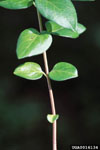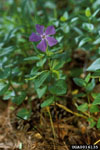PeriwinkleVinca major |
|||
| |
Click on thumbnails for larger view |
||
BackgroundIdentification
Identification key in: Hickman, J. ed. 1993. The Jepson Manual: Higher Plants of California. University of California Press. Growth and spread
Habitat and local distribution
Impacts
Prevention and ControlPrevention
Manual or mechanical control(Wright 1996)
Biological control
Chemical control
References and more information
Bean, C. and M.J. Russo 2003. Element Stewardship Abstract for
Vinca Major, periwinkle. The Nature Conservancy, Wildland Invasive Species
Team. Arlington, VA. Available at http://tncweeds.ucdavis.edu/esadocs/vincmajo.html.
Danielsen, C. W., R. McClure, E. Leong, M. Kelley, and C. Rice. 2003. Vegetation Management Almanac for the East Bay Hills. Hills Emergency Forum, a consortium of eight local governments. Available from East Bay Regional Parks, Environmental Education Center, Tilden Park. (510) 528-6619. Gibbons, M.V., M.G. Rosenkranz, H.L. Gibbons, Jr., and M.D. Sytsma. 1999. Guide for Developing Integrated Aquatic Vegetation Management in Oregon. Center for Lakes and Reservoirs, Portland State University, Portland, OR. Hickman, J. ed. 1993. The Jepson Manual: Higher Plants of California. University of California Press. Wright, Robert. 1996. Preliminary Results form a Vinca Major Removal Experiment. Proceedings from the 1996 California Exotic Pest Plant Council Symposium.
|
|||
| This page has been accessed | times. |



